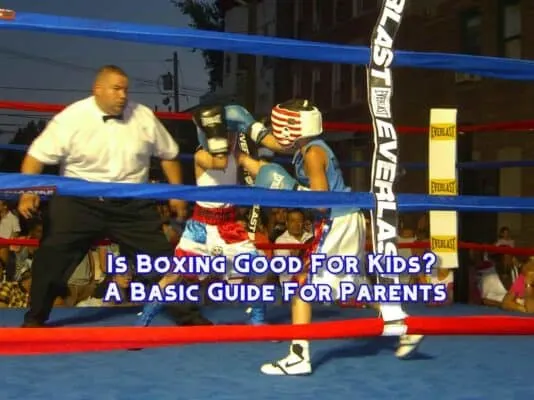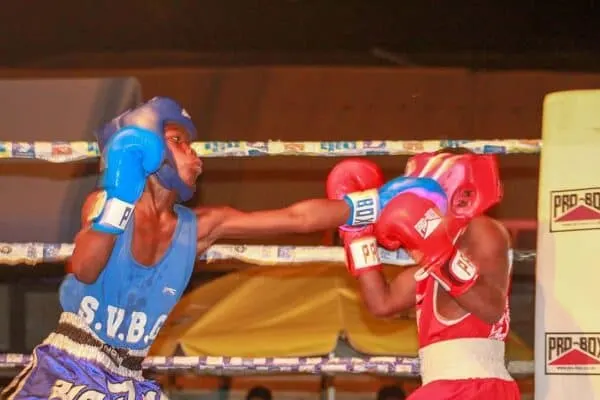
Disclaimer: The contents of this website, such as text, graphics, images and other material are intended for informational and educational purposes only and not for the purpose of rendering medical advice. The contents of this website are not intended to substitute for professional medical advice, diagnosis or treatment.
When it comes to kids training in martial arts, most parents do not consider boxing as a good option due to the perceived risk associated with boxers getting knocked out. Most parents consider boxing to be a combat sport for adults and do not regard boxing as benign martial arts such as karate or taekwondo. But is this just a myth people believe in, or is boxing really too dangerous for kids?
Boxing classes are great for kids as it improves both, their physical and mental health, and above all, it is very safe to learn when taught correctly. Among many other benefits, it improves their cognitive functions, strength, and reduces anger.
Boxing training is also cardio intense and will make your kid healthier, stronger, a better person, and teach valuable self-defense tactics. In this article, you will learn all the pros and cons of boxing for kids, and whether boxing is better and safer than other martial arts.
What Age Can Children Start Boxing?
Children can start boxing as soon as they show interest in it regardless of age. Each modern gym includes a “junior” group where kids do types of workouts according to their age and abilities. Here is how it works in practice.
- Most kids below 7 or 8 years old do not have enough strength, motor skills, and coordination to do intense and advanced drills and exercises. Instead, they do various strength and cardio workouts designed to meet their abilities, and above all, to be carried out in a playful way. Of course, there is no sparring, contact of any kind, and the main point is to tire kids out and provide them with a good workout. In the end, what a 5 year old know about the technical aspects of boxing? The only thing they care about is to play and have a lot of fun. The other problem is that you will have a hard time finding gloves small enough to fit their hands.
- 9 or 10 year olds is an age group where most kids have enough strength and ability to better understand the technical aspects of boxing. This is where the intensity of the workouts increases and they start doing real boxing workouts. At this age, kids spend most of the time hitting the pads, doing heavy bag workouts, jump ropes, and doing basic bodyweight exercises. In some schools, they might even do some light sparring(with protective gears) or live drills with the partner to prepare for sparring, but this varies between the gyms.
- The age of 12 or 13 is when most parents decide to enroll their kids in boxing. At this age, most kids are athletic enough to start with proper boxing workouts. They have enough body awareness and coordination, and the ability to develop strong mental habits and discipline. This is also where they start doing sparring and taking part in amateur competitions.
RECOMMENDED FOR YOU: Top 3 Best Martial Arts For Kids – A Basic Guide For Parents
What Are The Benefits Of Boxing For Kids?
Boxing is not just an activity where kids learn fighting techniques. No, it also has many other physical and mental benefits that will improve their overall health and have a positive impact on their lives outside the gym as well. Here are all the major benefits of boxing explained in more detail:
Health benefits
Boxing is an intense, full-body workout that will help your kid lose extra weight, prevent obesity, and make their muscles stronger and more flexible, which is crucial for overall health. For instance, kids who train in boxing tend to have a much lower Body Mass Index (BMI) than other kids since they burn more calories and fat. This on the other side enables them to eat more and develop good eating habits, which is a mission impossible for most parents you would agree. Cardio intense workouts also improve their cardiovascular health, decrease anger and stress, and help them sleep better.
Physical health
In junior boxing classes, kids do a lot of bodyweight exercises, and also stretch a lot. They do sit-ups, squats, various types of jumps, sprints, all with very little rest and a lot of sweating.
Classes are a mix of anaerobic and aerobic workouts. Or in other words, it improves both their strength (anaerobic), and boost endurance and cardio (aerobic). On top of that, boxing improves their motor skills, hand-eye coordination, flexibility, and balance.
Mental health
- Social skills — is one of those things you want your kid to develop as soon as possible. Each junior boxing group includes 10, 20, or more kids working together. Under a good coaching staff, they will learn all about respect, teamwork, and how to communicate and control their emotions. Being in a group of other kids and in a friendly atmosphere also decreases social anxiety and improves social skills.
- Confidence — is one of the most important things in life, especially at a young age. Their confidence will start to rise as soon as they begin to work hard, make progress, and start gaining muscles, and being good at boxing. It will give them wings to achieve anything they want in this life.
- Discipline — is the furthest thing from kids. But this is where boxing helps parents a lot. Just about every boxing gym maintains a high level of discipline where all students must stay quiet, learn how to listen and obey orders. The level of discipline in a boxing gym can often be even higher than in school for example. This also might have a positive impact on the way they approach school and obligations outside the gym.
- Reduces aggressive behavior — is one of the main worries of every parent out there, and yes, boxing helps children address anger issues. It allows them to reduce negative feelings and anger through hard work and a positive atmosphere. Each time they train hard, the mind will release chemicals like serotonin and dopamine, which instead of feeling anger, will lift their mood up and make them happy.
Improves self-defense abilities
Boxing is one of the most effective combat systems and each technique students learn works in real life as well. It will teach your child how to defend, but only to use boxing skills as a last resort. In training, coaches will teach them how to avoid conflict first, stay neutral or even run away before using boxing skills.
RECOMMENDED FOR YOU: Is Boxing Considered A Martial Art? Yes, Here’s Why
What Are The Negatives of Boxing For Kids?
The biggest downside of boxing for kids is the high risk of head injuries which most gyms are trying to reduce. Boxing is a system where athletes use only their hands as weapons to strike the head or the body area below the neck and above the waist. That being said, boxers absorb a lot of head and body shots, which often result in minor or serious injuries.
In most gyms, kids do not start sparring or having any type of physical contact before they are 12 or 13 years old. Or in other words, your kid won’t exchange punches with other kids, neither will they “fight” each other in training. Even when they start sparring at 13 years of age, for example, they all must wear protective gear like full padded gloves, a thick padded boxing helmet, and keep it all light. In the months leading up to their first sparring session, they will learn how to use as little as 30% or 50% of power, and focus on technique.
This reduces the risk of injuries like brain traumas, concussions, or rib and hand fractures. But bear in mind that these methods do not eliminate the risk. On the other side, kids are likely to suffer a concussion in other sports such as rugby or football. Both of these sports include a high rate of brain injuries, even higher than some martial arts.
Does Boxing Make Kids More Violent?
No, boxing doesn’t make kids more violent, in fact, it does the total opposite of that in most cases. First of all, boxing allows kids to get familiar with all the dangers of violence at a very young age. They will feel on their own skin how punches hurt, that being a bully does not mean you know how to fight or make you strong, and above all, that violent behavior only leads to more trouble. But, can boxing actually help kids with anger issues?
Some kids come into boxing with anger issues. But the intensity of these issues would start to drop as soon as they feel how it is to be on the receiving end against a skilled teammate. Over time, this will put their ego into place, and make them more humble. Also, an intense physical workout in a positive atmosphere releases various “happy” hormones like serotonin, which instantly reduces anger and makes them feel happy.
In the end, a good boxing gym maintains a high level of discipline and encourages respect between the students. Coaches are role models, leaders, and pay extra attention to teaching kids valuable life lessons. They pay even more attention to kids with anger issues, and will give their best to convert their anger into productive work, but not without the support of kids’ parents at home.
They will not tolerate any type of mental or physical bullying in classes. Instead of letting the kids fight, they will teach them how to stay calm, rethink, and communicate. This improves empathy, self-control, and with that, reduces anger.
RECOMMENDED FOR YOU: Will Martial Art Make My Child More Aggressive?
Does Boxing Stunt Growth For Kids?
Boxing does not stunt kids’ growth and not a single study supports this claim. Or in other words, this is just a myth that people believe in due to the fact that the most famous boxers tend to be short in height. Yes, being short has many benefits when it comes to fighting. But boxing as a workout does not make you, your kid, or any other human, shorter or will stunt your growth.
In fact, studies have shown the total opposite. Training can only increase the secretion of growth hormone and support the growth of tissues and bones, and with that, height.
RECOMMENDED FOR YOU: Does Wrestling at an Early Age Stunt Your Growth?
Is Boxing Effective For Self-Defense?
Boxing is one of the best systems kids can learn for self-defense. It will teach them all about the physical and mental aspects of fighting, and effective techniques that might help them in trouble. Yes, it is a bit limited compared with other arts as boxers use “only” their hands as weapons in a fight. But on the other side, it is still better than most other systems, and here is why.
The most common way of the attack on the streets is by swinging a punch both when it comes to adults and kids. This is the easiest, fastest, and the most natural way one can hurt a person standing in front. You will rarely see people going for a takedown, clinch, or throwing a kick. And no other martial art than boxing would teach you how to better defend against punches on the streets.

In training, students learn how to block, slip, dodge punches, use footwork to keep distance or create angles, and hands to deliver hard and laser precise punches. They do various drills like sparring to learn how to apply these skills in practice, develop timing, feeling for distance, and keep their mind calm in the heat of the moment.
In fact, boxing puts a lot of emphasis on sparring as the best method one can prepare for real combat. Students spend a lot of time simulating a real fight against their partner, which may be a bit scary at first. But over time, you will learn how to control your emotions, stay focused, and make rational decisions while punches are flying.
RECOMMENDED FOR YOU: Is Boxing Good for Self Defense? The Ultimate Answers
Which Is Better Boxing Or Kickboxing For Kids?
Both of these arts are very similar when it comes to classes for kids, and share very much the same benefits. Both include junior classes where children do not spar up until they are 10 years old at least, and the structure of the training is very similar.
In classes, kids do various playful drills that will make their bodies strong, and teach them basic fighting skills. Which one is better really comes down to personal preference. The best way to find out is to let your child attend a trial class in both arts, and let them make a final decision.
- Number of techniques — kickboxing has more techniques because it consists of hand, leg, knee, and elbow (not in all styles) strikes.
- Takes less time to learn — boxing is easier to learn simply because students learn less techniques. On average, they need from 6 months to 1 year to develop solid skills that they can apply in a real fight. Kickboxing is not that complex either, but it takes a bit more time, 1 to 2 years to be more precise.
- Injuries — the risk of injuries is the same in both arts, maybe a bit higher in kickboxing because of the kicks. But boxing, on the other side, carries a higher risk of head and face injuries due to its emphasis on head strikes.
RECOMMENDED FOR YOU: 10 Tips To Spot Bad Martial Art Schools For Beginners
Final Thoughts
Most parents do not see boxing as the best option for their child due to its violent nature. However, boxing for kids has much more pros than cons when it comes to their physical and mental health, and improving their self-defense abilities. In most gyms, junior boxing classes are very safe because there is no sparring until your child turns 10 or more, and the safety and health of the kids is always the number one priority of the coaching staff. When it comes to injuries in training, junior boxing is nothing more dangerous than football, rugby, and even soccer.
The best thing you as a parent could do is to give boxing a chance. Instead of judging the sport and classes by the pro matches you see on TV, visit the boxing gym and have a talk with the coaching staff about the classes, methods they are using, safety, and all other issues. Be sure to observe the classes if that is what’s going to convince you that boxing is, indeed, safe for your child.
SUGGESTED READING: Is BJJ Good For Kids? Parents Easy Guide to BJJ
